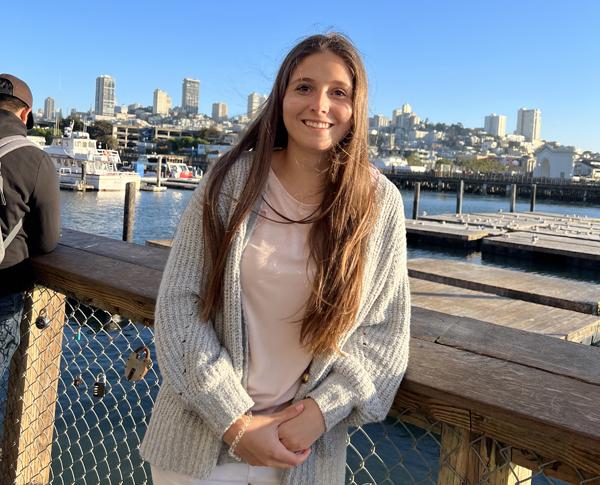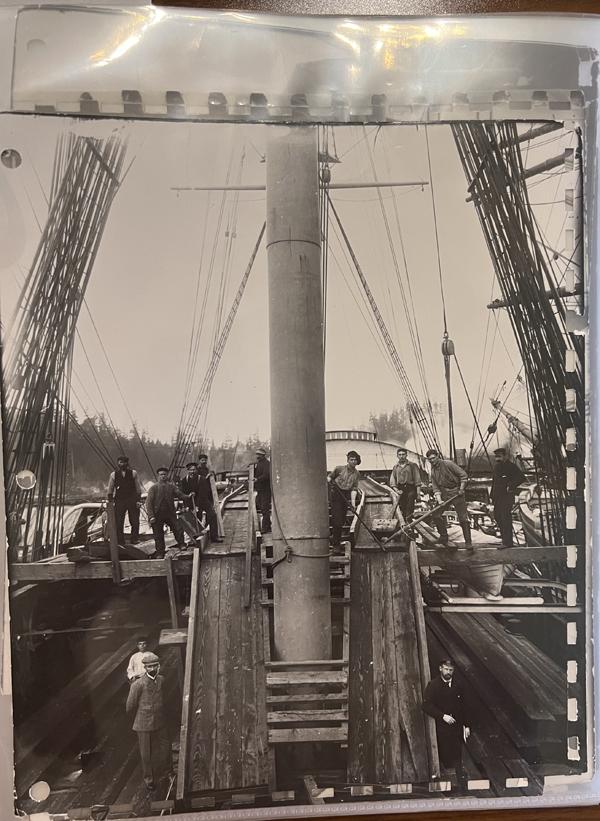
Taylor Vickers delves into San Francisco archives to help Kathleen Sullivan research sailor boardinghouses

To help Kathleen Sullivan (opens in a new window) with her research, undergraduate student Taylor Vickers had to travel to San Francisco—and to a time in history when Mark Twain wrote about the city of then-450,000 people as an emerging center of commerce between the old world and the new.
Sullivan's book manuscript deals with government regulation, or the lack thereof, over boardinghouses for sailors between 1866-1915. The wooden boardinghouses, long ago replaced by tourist attractions along San Francisco's docks, aimed to provide housing and entertainment for the seamen. But their proprietors actually came to dominate the workforce needed to keep shipping afloat—until federal legislation and the push to unionize came to sailors' aid by 1915.
The original documents that Sullivan needed exist only in the boxes of 100-year-old documents and personal items stored in library archives in the San Francisco Bay Area.
"I was able to research the San Francisco waterfront from secondary literature and older books and journals in digital archives, and we can access congressional hearings through the Proquest database at Alden Library. But archival collections have a wealth of private correspondence, handwritten ledgers, photographs, and other one-of-a-kind documents that add depth and detail to the information we can access online," said Sullivan, associate professor of Political Science (opens in a new window) and graduate program director of the M.A. in Law, Justice & Culture (opens in a new window) in the College of Arts and Sciences at Ohio University.
While she originally planned to make the trip herself, the pandemic provided enough hurdles that Sullivan approached Vickers about making the trip in her stead.
So for a week in June, Vickers found herself in places usually the purview of professors and doctoral students.
"Many of the archivists and other researchers were very surprised to learn I was an undergraduate student. When talking with them, many automatically assumed I was a doctoral student and began asking specific questions about the research I was doing. After telling them my actual age, there was always this look of shock and line of questions about how I got to this point," said Vickers, now in her senior year at OHIO. She is pursuing a B.A. in Political Science (opens in a new window), a B.S. in Psychology (opens in a new window), a Law, Justice & Culture Certificate (opens in a new window), and a Sociology Minor (opens in a new window), with plans to go to law school.
Getting Ready for the Archives
As Sullivan considered how to complete her research, Vickers came to mind.
"Taylor has been both a student in my classes and my advisee. She’d recently expressed a wish to do something more, so when this opportunity came up, I already knew of her interest and her capabilities," Sullivan said.
With funding from a Center for Law, Justice & Culture (opens in a new window) research grant and an Undergraduate Summer Internship grant from OHIO's Office of Research and Creative Activity, Vickers prepared to go to San Francisco to find documents about the Sailor’s Union of the Pacific and other maritime unions and the workings of the office of the U.S. Shipping Commissioner in the Port of San Francisco.
Since she would spend one whirlwind week visiting archives at UC Berkeley, San Francisco State University, the National Archives at San Francisco, and the Maritime National Historical Park, Vickers needed to do more than pack a suitcase before her trip.
"Since this was my first time doing archival research, Dr. Sullivan thought it would be a good idea for me to visit the OHIO archives to get a better idea of the work I would be doing in San Francisco. Before I left, we scheduled an appointment with Greta Suiter at the OHIO Archives located within Alden library. Greta taught me the procedures necessary when examining the historical documents. For example, only pulling one folder at a time and recognizing when I may need to use a book cradle (for a fragile document)," Vickers said.
Finding Her Way in the Bay Area
Neither fragile paper nor traversing back and forth under the San Francisco Bay on public transit would keep Vickers from accomplishing her mission.
"Naturally, I was very intimidated during my first couple days at the archives because there was so much information, and I did not want to be missing anything important. However, I would say my ah-ha moment finally came when I was going through material and understood the context enough to know how it benefits the project. I also felt confident in myself once I was able to conquer the BART (Bay Area Rapid Transit) and get home in the evenings," Vickers said.
Vickers and Sullivan spent time before the trip going over how to determine what information was relevant, and they came up with a system to stay in constant communication. While Vickers was looking through papers browned by age, she and Sullivan used modern technology to share the experience.
"Archive catalogs provide finding aids, which give you an idea of what’s in a collection, but you don’t really know what’s in there until you open a folder of documents for yourself. I gave Taylor guidance beforehand about what sorts of items we were looking for. She then used her own discretion to set aside a folder as irrelevant for our purposes, or to identify it as worthy of a closer look. She’d text me a photo of some sample documents to see if that’s the sort of thing I wanted. Once she started taking photos of a folder, she uploaded them to a shared Google Photos folder, which I could see right away and advise whether we should keep photographing that folder or move on," Sullivan said.
"We rigged up a decent system. I processed the photos in Athens while Taylor kept delivering them from San Francisco," Sullivan added. "A couple of boxes didn’t have a finding aid, so we didn’t even know what was in there until Taylor got the box. Taylor took videos of herself scrolling past each folder title in the box and texted that to me. I’d then watch the video and text back the folders I wanted her to look at. It was tedious work, and Taylor showed excellent communication skills and endless patience."
Exploring 19th Century San Francisco
Sullivan's research—and Vickers' archival work—deals with state and federal protection of seamen from sailors boardinghouses. What was San Francisco like in the late 19th century, especially for the sailors?
"Nineteenth-century songs and tracts recounted stories of boardinghouse keepers who would ply seamen with all sorts of entertainment when they were on shore until the seamen ran up a debt. Then the boardinghouse keeper would take a sailor to the dock, have him sign a contract for a new voyage, and pocket the seaman’s advance wages as payment for the debt. This was called crimping. After the Civil War, a few states and the federal government passed laws prohibiting it, but these laws weren’t designed to actually help seamen, so crimping continued. Sailors eventually organized on the West Coast ports, and seamen’s labor unions were responsible for a law that actually served seamen’s stated needs in 1915," Sullivan said.
Near the Ferry Building, which now has nice restaurants, shops, and a farmer’s market, there was a block of boardinghouses, two-story wooden buildings lining both sides of the street. The boardinghouse keepers were likely to be former seamen themselves, and they provided familiar spaces to seamen ashore, offering relief and a good time after the harsh conditions on ships.
"The boardinghouse keepers, with names like 'Scab Johnnie,' 'Old Man Harge,' and 'Jack the Ripper,' inveigled seamen while sustaining tough reputations. John Curtin, a one-eyed landlord, allowed stories to circulate about a violent fight with a bucko mate from his days on ship, when basically he received his eye injury while working as a ship’s carpenter. But he didn’t let the truth get in the way of a good rumor," Sullivan said, noting that these insights came from one of Vicker's archive discoveries.
"However colorful their reputations, boardinghouse keepers were essentially shipping agents. Oral histories of seamen indicate that if a sailor wanted a spot on a ship, he needed to be shipped through a sailors boardinghouse. A captain needed to round up a crew when he arrived in port, and the boardinghouse keeper very conveniently supplied the men to staff the ship by bringing around seamen to sign a new shipping contract. Captains benefitted, boardinghouse keepers benefitted, maritime commerce kept moving, and that’s why any exploitation of seamen was tolerated for so long," Sullivan added.
Adding to the Political History of 19th-Century San Francisco
Sullivan said some of the most useful items Vickers discovered were the records kept by a U.S. Shipping Commissioner based in San Francisco.
"He was—unusual for a shipping commissioner—a former seaman and union member. He documented the boardinghouse culture of San Francisco. His private correspondence provides a glimpse of his networking in Washington, D.C., and within the business and political communities of San Francisco. It seems he was well regarded by all corners of the political community, and he was earnest in his work, making sure that seamen were treated fairly. His papers allow us to see the formal and informal politics of his position."
Sullivan said she was going to end her book with the Seamen’s Act of 1915, but the documents that Vickers helped uncover showed the shipowner-labor politics shifted to a different venue. According to Sullivan, while the pair expanded their timeline to photograph additional documents, "at some point you have to stop, but these unexpected documents will provide an epilogue to my study and more insight into the significance of this project for American political development."
"Her work this summer exceeded my expectations. She was amenable to the pace of archival research, which can present a dead end one minute and a treasure trove the next. It was a lot of fun to share that experience and to collaborate together. I’m grateful to Taylor for all of her assistance and good will, to OHIO’s Mahn Center for Archives and Special Collections for in-person training, and to OHIO for supporting faculty research activity and student experience in these trying times," Sullivan said.
Vickers: 'Step out of your comfort zone'
"This was my first time visiting the West Coast, so I was very excited to be asked to go on this trip. Once I arrived in San Francisco, I was in awe of how big the city was and how much there was to do right by my hotel. Fortunately, I was able to do some more touristy things like see the Golden Gate Bridge, visit Fisherman’s Wharf, and ride on a streetcar. One thing that did catch me off guard was how chilly the weather was in the afternoon which made me very thankful I brought a sweater with me," said Vickers, recalling her time in the Bay Area.
"Also, the hills in San Francisco made Jeff Hill look easy," she added.
In addition to adding some experiences to her resume, Vickers said she also learned valuable research skills and attention to detail, "qualities I will be using in my future career. Additionally, through this experience I learned how to be adaptable on the spot, which is something I will carry into my personal life.
What’s the one thing Vickers would tell a new OHIO student not to miss?
"Step outside your comfort zone," she said. "OHIO has so many amazing things to offer that could be a once-in-a-lifetime opportunity for students, and it’s so important to take advantage of that. Not only are you left with amazing memories, but most importantly it helps you grow academically and personally!"



